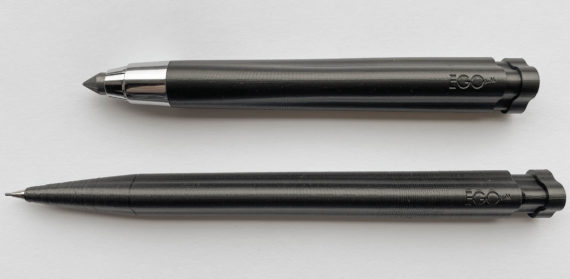The EGO.M Cento 3 – a graphene pencil

A few weeks ago I received a surprise parcel from John Hall of Write Here fame. Inside the parcel were two rather unusual pens that I have been using regularly since then. It’s time to send them back soon, but before I do that I want to show you these very special pens and talk about their unusual design.

You can also find a video about the Cento3 on the Bleistift Youtube channel:
The mystery of a pen body made from graphene
Let’s get their most exotic property out of the way first: these pens are 3d printed from graphene. With graphene not being very think (one layer of atoms) you could think of it as being two-dimensional. You also commonly read that a one atom thick layer of graphite is graphene. With that in mind I am wondering how something three-dimensional can be graphene without turning into graphite. Maybe it is a flat ‘two-dimensional’ layer rolled up with some other material in between, but in that case, does it keep graphene’s properties and are they desirable in a pen body in the first place? So many questions….

I also wonder whether creating the Cento3 pen body requires very special 3d printers so that the graphene layers don’t melt together into a lump of graphite and whether the body has some sort of lacquer on top. Whatever the answers to all my questions are, the pen that Ego.M have produced is a very special pen and as I don’t understand enough about materials science I will just go along with the claim that this pen is made from graphene.
The design’s history
The idea for this pen was thought up 20 years ago, in 2001, when Achille Castiglione and Gianfranco Cavaglia came up with a pen design using the ‘trilobate’ shape. Think of three slim pens arranged together like a three-leaved clover and connected – I hope the image below gives you a better idea than my short description.

At the time some non-working prototypes were made from wood, but the pen was not commercially produced until recently when the prototypes were rediscovered by the designer’s children and EGO.M, based in Bologna, started developing the prototypes into commercially produced pens which were then officially released in February 2021, 103 years (100 = Cento, so Cento3 = 103) after Achille Castiglione was born.
About the pen
Surface
The first thing most people will notice when they look at this pen is that the individual strands of extruded plastic filament are quite visible. On the body of the mechanical pencil I received for testing the pattern produced by the 3d printing process is much less ‘even’ than on the lead holder I got. I assume every pen is unique in this respect and if you pick another sample this might be different, i.e. another mechanical pencil might look ‘smoother’ and another lead holder might look less smooth. The uneven surface loves to attract dust which is quite visible if you enlarge the photos.

Weight
The next thing to notice is that for their length and diameter the Cento3 pens are quite light. In the diagram below you can see that compared to some of the mechanical pencils we looked at in the past only slim and plastic-y mechanical pencils and tiny mechanical pencils are lighter than the Cento3 mechanical pencil.

Amateurs like me often like heavy pens as they give the user the feeling of being more substantial and of higher quality, but professionals actually like light pens. It makes sense to use a light pen that isn’t tiring when you use it all day long.
Mechanism and ageing
I was not able to figure out what kind of mechanism is used in the mechanical pencil as I don’t see a non-destructive way of getting to the mechanism. I assume the 3d printing of the body is done directly on the mechanism.
Pens change over time. One example is the beautiful surface of the Lamy 2000. Over time it becomes more and more smooth and shiny. I am not sure how hard the filament is that was used to print the Cento3, but there is a good chance that over the years the surface might become more and more smooth. This is just a guess, but it might change the character of he pen over time.
The weight and shape make the pen surprisingly comfortable to hold and use. The 3d printed structure provides a good grip when you hold the mechanical pencil. Many mechanical pencil users rotate the pen automatically and even subconsciously to make the lead use up more evenly. This is slightly more difficult with the Cento3 compared to a thinner pen, but it is possible without hassle.
The lead holder
In my opinion the lead holder version of the Cento3 feels much posher than the mechanical pencil. Maybe it is down to the chrome-y front section or the more even printing of the filaments.

Conclusion
These pens are a great innovation. They are not the first 3d printed pens available, but the first ones I know of with the graphene link. The mechanical pencil sells for £60, as does the lead holder. There’s also a fountain pen version for £80.
Thanks to John for lending me these for my blog post and video.
If you want to find out more about these pens you can do so
Please note that the pen is properly black, I just lit it so that you can see the surface well which made it looks less black on my photos than it actually is.
The EGO.M Cento 3 – a graphene pencil Read More »
